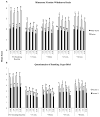Response to varying the nicotine content of cigarettes in vulnerable populations: an initial experimental examination of acute effects
- PMID: 27714427
- PMCID: PMC5203959
- DOI: 10.1007/s00213-016-4438-z
Response to varying the nicotine content of cigarettes in vulnerable populations: an initial experimental examination of acute effects
Abstract
Rationale: The purpose of this study was to begin researching the effects of very low nicotine content cigarettes in smokers especially vulnerable to dependence to assess their potential as a less dependence-producing alternative to current commercial cigarettes.
Methods: Participants were 26 adult, daily cigarette smokers from one of three populations: economically disadvantaged women of reproductive age (n = 9), opioid-dependent individuals (n = 11), and individuals with affective disorders (n = 6). Participants completed fourteen 2-4-h experimental sessions in a within-subjects research design. Sessions were conducted following brief smoking abstinence. Four research cigarettes varying in nicotine content (0.4, 2.4, 5.2, and 15.8 mg/g) were studied under double-blind conditions, assessing smoking topography, subjective effects, and relative reinforcing effects of varying doses in concurrent choice tests. Results were collapsed across vulnerable populations and analyzed using repeated measures ANOVA.
Results: No significant differences between doses were discernible in smoking topography. All doses were equi-effective at reducing nicotine withdrawal. Ratings of satisfaction from smoking were lower at the 0.4 compared to 15.8 mg/g dose. Participants preferred the 15.8 mg/g dose over the 0.4 and 2.4 but not the 5.2 mg/g doses in concurrent choice testing; no differences between the two lowest doses were noted.
Conclusions: All cigarettes effectively reduced nicotine withdrawal with no differences in smoking topography, suggesting minimal compensatory smoking. Dependence potential was lowest at the 0.4 mg/g dose. These initial results are promising regarding the feasibility of lowering nicotine content in cigarettes to very low levels in vulnerable populations without untoward effects.
Keywords: Abuse liability; Acute exposure; Cigarette smoking; Concurrent choice testing; Nicotine; Nicotine dependence; Nicotine withdrawal; Smoking topography; Tobacco; Very low nicotine content cigarettes; Vulnerable populations.
Figures


References
-
- Benowitz NL, Henningfield JE. Establishing a nicotine threshold for addiction: the implications for tobacco regulation. New England Journal of Medicine. 1994;331:123–5. - PubMed
-
- Benowitz NL, Hall SM, Stewart S, Wilson M, Dempsey D, Jacob P., III Nicotine and carcinogen exposure with smoking of progressively reduced nicotine content cigarette. Cancer Epidemiology, Biomarkers & Prevention. 2007;16:2479–85. - PubMed
MeSH terms
Substances
Grants and funding
LinkOut - more resources
Full Text Sources
Other Literature Sources

